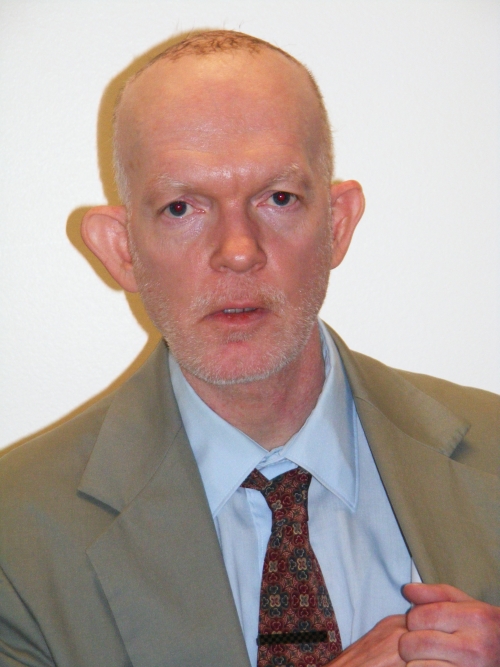
Mark Landis
Also known Aliases:
2009 – Steven Gardiner
2010 – Father Arthur Scott
2011 – Father James Brantley
2012 – Mark Lanois
How does one detect a forgery you may ask? I have had not formal training or education into investigation. I was curious about the Signac gifted to the Savannah College of Art and Design (SCAD) and the Lepine gifted to St. Louis1. When I started to get suspicious, my anal retentive, registrar, OCD frame of thinking kicked in. I looked at the six gifts from Landis to Oklahoma City under a simple magnifying lupe and ultraviolet light. Each piece, the Signac, Lepine, Daumier, Laurencin, red chalk 17th century drawing and Valtat that we had received earlier, all had some kind of querky things about them. The Lepine glowed white under black light. Why? Where ever Landis did not use his 20th century oils to paint over the digital reproduction, they glowed white. The red chalk drawing supposed to be 17th century… not only did areas in question glow white or a dark blue but there was some other tool I used to confirm my suspicion… my nose. For a 17th century drawing to be authentic, the matting it was affixed to should have been brittle and snapped with little effort. I remember peeling back the lower left corner of the mat expecting it to snap, not harming the image, and guess what… it was stark white… brand new. Then I lifted the exposed area to my nose and it smelled like COFFEE! Fake!
After having conversations with more than 20 institutions in less than 60 minutes, I uncovered the most prolific art forger of our time. But not like any that has been shopped in the past, but an unusual character that was not in it for the money, but to be philanthropic, honor if mother and dad and to be treated ‘nice’. Landis had no interest in seeing the FAUX Real exhibition I put together at the University of Cincinnati last April. And I quote ‘I don’t care to see this stuff, I have already seen it. Is there anyone here to speak to that is nice? Yeah, that would be nice. Is there anyone here to talk to that is nice?’. Words from Landis… try three days of this as I did in the summer of 2008… it will wear you out. So my fellow sleuths, don’t be afraid to use your gut instinct and ask questions. You just be the next registrar to uncover something as big as my case on Mark Augustus Landis. Discerning eyes, experience, due diligence, patience, inquisitive nature… don’t take things at face value. You may get duped!
More specifics on this scam coming soon. I could write for hours on this case but I am trying to keep my two week series concise only giving you enough to wonder why and get you thinking. Oh wait until I share the forgery of the Picasso! Remember to look for my contact information is on the authors page of Registrar Trek. Talk soon!
Matt
Read more:
- FAUX Real – Happy New Year Trekkers
- FAUX Real: News from Art and Craft
- FAUX Real: On the Trail of an Art Forger – Art and Craft Trailer
- FAUX Real – How did I get here?
- FAUX Real: Art and Craft – The Film
- FAUX Real: On the Trail of an Art Forger – Short Notice II
- FAUX Real: On the Trail of an Art Forger – Short Notice
- FAUX Real: On the Trail of an Art Forger Part 11
– Final Entry for 2013 - FAUX Real: On the Trail of an Art Forger Part 10
- FAUX Real: On the Trail of an Art Forger Part 9
- FAUX Real: On the Trail of an Art Forger Part 8
- FAUX Real: On the Trail of an Art Forger Part 7
- FAUX Real: On the Trail of an Art Forger Part 6
- FAUX Real: On the Trail of an Art Forger Part 5
- FAUX Real: On the Trail of an Art Forger Part 4
- FAUX Real: On the Trail of an Art Forger Part 2
- FAUX Real: On the Trail of an Art Forger Part 1